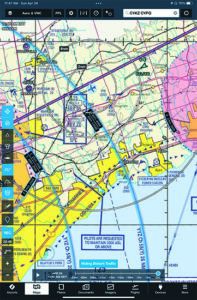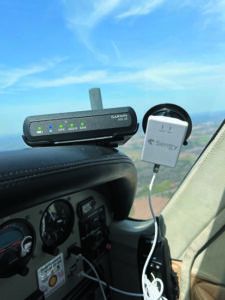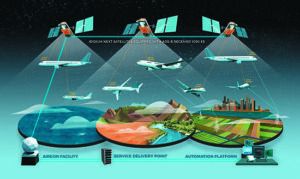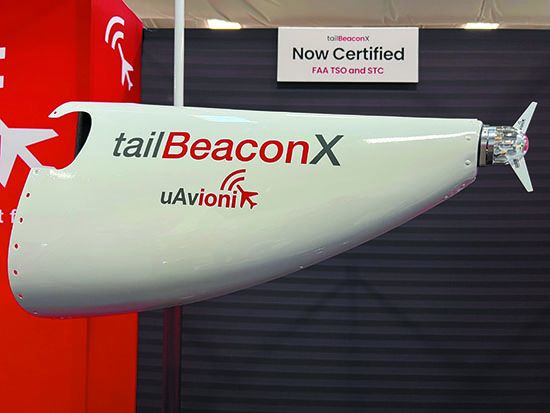The proposed ADS-B requirements for Canadian airspace have been a moving target the past couple of years. And while ADS-B for flying south of the border is old news, Transport Canada (TC) and Nav Canada (NC) have quietly gone their own way implementing an ADS-B solution that is not entirely compatible with the technology mandated by the FAA over a decade ago.
Put on a slow simmer over a year ago, Canada’s space-based ADS-B solution has created confusion, fear, uncertainty and doubt in the minds of both Canadian and American pilots. Here’s an update as the mandate once again gains momentum.
EQUIPMENT AND INFRASTRUCTURE
To be clear, Transport Canada has yet to ratify or mandate ADS-B equipage for general aviation ops. With the expanse of the Canadian land mass, a small number of airports, the decommissioning of the VOR infrastructure, avoiding a costly radar upgrade project and Nav Canada’s 37 percent investment in Aireon (www.aireon.com)—a satellite tech company—a satellite-based mandate is in Canadian GA’s future. NC’s mandate pertains to the effective utilization of Canadian airspace and ATC resources. Unlike U.S. ADS-B, it is not mandated to provide traffic or weather information to aircraft. TC’s plan called for “mandatory use of ADS-B in designated airspace, between 2018 and 2022.” Those dates have been pushed to 2023 and 2026. More on this in a minute.
The infrastructure is based upon space-based satellite communications delivered over 1090 MHz, and provides limited traffic information to both panel-mounted systems and portable receivers. Essentially it’s ADS-B only (no FIS-B datalink weather or TIS-B traffic, simply known as ADS-B In). Canada’s ADS-B standard is documented by RTCA DO-260B.

To comply with Canada’s proposed ADS-B environment, the aircraft must have a 1090 MHz transponder (enhanced squitter) with a skyward-facing antenna and a WAAS GPS source. Aircraft installed with 978 UAT technology like the uAvionix’s skyBeacon or tailBeacon (the tailBeaconX will work), Garmin’s GDL 82, BendixKing KGX 150/130, FreeFlight Systems FDL-978 series and Sandia Aerospace STX 360 Sentinal will not be compliant with the Canadian mandate. Moreover, 1090 MHz systems with antennas facing the ground will also be non-compliant. Canadian early adopters of ADS-B tech to support the U.S. mandate face major and costly upgrades.
ADVOCACY
The 2022 state of affairs brings into context a number of interesting questions for TC and NC. With NC pushing the ADS-B agenda, have TC and NC created an environment in which the traditional aeronautical study process, involving consultation with stakeholders (like COPA, CBAA, AOPA, EAA, NBAA, to name just a few) has been circumvented to avoid escalating ADS-B up the political and bureaucratic chain of command? Who thought that there wasn’t intrigue, money and politics in ADS-B? The conversation gets further muddied with the utilization of space-based ADS-B as a replacement to 121.5 and 406 MHz ELTs. In a nutshell, industry organizations like COPA, AOPA, CBAA, EAA, NBAA, to name a few, sent a letter to the Honorary Omar Alghabra, Minister of Transportation (tinyurl.com/yr5z7v2t), concerned about the lack of regulatory consultation leading up to a February 2022 announcement by NC to mandate changes to transponder equipage requirements.
“No one is questioning the safety benefits which ADS-B can provide, just like no one questioned the safety benefits of GPS,” Christine Gervais, president and CEO of COPA, said publicly. Gervais pointed out that there is no regulatory requirement for GA aircraft to equip with GPS. TC and NC have created an environment whereby circumventing the regulatory approval and consultation process fills the needs of NC on the financial backs of GA and BA. TC issuing AC-500-029 illustrates its attempt to circumvent the process, which could cost upward of $750,000,000 to be spent by aircraft owners and operators to meet an ADS-B equipage requirement, with no direct benefits. This is not being presented as a requirement for safety.
As for U.S. GA aircraft—the majority of which will not meet the equipage requirements—it seems that TC and NC have turned a blind eye. But the issue is much bigger than ADS-B equipage; it is setting the stage for circumventing the process for any other potential future regulatory requirements. “Without this process, it is guaranteed the needs and concerns of impacted stakeholders won’t be considered. The regulatory process was established to avoid this,“ Gervais said. Conservatively the cost of Canadian equipage could be $7.5 million or more in Canadian dollars.
Canadian Business Aviation Association (CBAA) sees the 2022 looming deadline as one impacting compliance based upon supply chain issues. Anthony Norejko, president and CEO, Canadian Business Aviation Association, reports: “While we don’t have specifics on the Canadian business aircraft fleet, we feel that roughly 30 percent will be challenged (especially with COVID-19-induced supply chain constraints) to meet a February 2023 deadline. The government needs to take a holistic approach to creating aviation policy impacting GA, BA and the airlines. The ADS-B issue represents one example of the federal government’s lack of an overarching aviation strategy.”
Tom Charpentier, EAA government relations director, is also on board.
“We want to see compatibility between the successful U.S. ADS-B systems and Canada’s new mandated systems, both for U.S. pilots who wish to cross the border and those in Canada who want to fly into the United States. While EAA does limited advocacy work outside the U.S., we will work to support our Canadian members in urging Transport Canada and Nav Canada to adopt a reasonable ADS-B mandate that minimizes the financial impact and hassle on aircraft owners in that country, while maintaining high levels of safety,” he said.
Brain Boudreau, Nav Canada’s manager of media relations, said “Canada is committed to an ADS-B mandate that will benefit the aviation community and it will continue to engage with stakeholders throughout the transition. Nav Canada recognizes that there is a cost to adequately equip aircraft, and this is being considered in the timelines and airspace classification. Implementation for Class C, D and E airspace will take place only after significant stakeholder consultation, and will occur no sooner than 2026. Transport Canada Civil Aviation (TCCA) and Nav Canada will work together to keep industry apprised of further details as they become available.”
STICK WITHOUT A CARROT
With no UAT environment in Canada, and for American registered aircraft flying north of the border, Canadian airport METARs and TAFs are not received over UAT. It’s like watching public weather on an American television channel, where the imagery stops at the border. Pro tip: If you need cockpit weather, consider a SiriusXM Aviation broadcast datalink subscription for access to Canadian data.
The ADS-B conversation becomes muddier when ADS-B Search and Rescue (SAR) alerting is considered. Essentially eliminating the need for a 406 MHz ELT (a regulatory requirement for GA by November 2025), NC sees an environment whereby ADS-B Out, big data, analytic and artificial intelligences can radically change the SAR landscape through eliminating false activations and pinpointing the geographic location of a downed aircraft. That said, there is a lot of work, development and testing required to actually implement this vision.
Nav Canada implemented ADS-B Out trials in James Bay in 2009, the eastern portion of the Canadian North in 2010 and the northeast coast of Canada in 2011 to 2012, supporting air navigation services to high flyers. The deployment of ground-based ADS-B became operational in 2008 to support high flyers above 29,000 feet.
Additional Nav Canada trials using space-based ADS-B in the Montreal Flight Information Region (FIR) began in December 2021 and were followed by trials in the Edmonton FIR in early 2022. The trials will help evaluate performance and gather pilot and air traffic controller feedback while addressing any potential technical issues prior to a mandate going into effect.
BUILDING THE TECH

In November of 2012, Aireon LLC was formed as a joint venture between Nav Canada and Iridium Communications, which facilitated the investment into space-based 1090ES ADS-B Out services. Other partners in Aireon include air navigation service providers NATS (U.K.), ENAV (Italy), the Irish Aviation Authority (Ireland) and Naviair (Denmark). The Aireon space-based system went live in March 2019, providing 100 percent worldwide coverage. Aireon utilizes Iridium’s low earth orbit (LEO) network of 66 satellites. With a satellite constellation orbiting at 780 km, Iridium provides communications coverage of the entire earth’s surface. To satisfy both a satellite (Canada) and ground-based (U.S.) mandate, the aircraft’s ADS-B transmitter must support antenna diversity. That’s one antenna installed on top of the aircraft facing the satellites and one antenna facing the ground to talk to the ground stations. The transponder itself must also have diversity circuitry. If your aircraft will never travel to the U.S., then an antenna installed on the top of the aircraft is all you need from an installation standpoint.
Nav Canada says that it will not invest in ground-based ADS-B technology like UAT, which is used to deliver traffic and weather information utilizing ADS-B In receivers. The mandate is restricted to managing the air traffic control environment and as such, the delivery of traffic and weather data into cockpits (via UAT) are outside of the mandate—which I find perplexing as Nav Canada is responsible for traffic and the delivery of weather information.
Nav Canada’s original plan saw two phases of ADS-B airspace implementation. Phase 1 was slated for February 2021 in Class A and Class E (above FL600) airspace. Phase 2 was slated for January 2022 in Class B airspace. But these plans have changed, pushing the requirement in Class A and B airspace to 2023.
A look at some U.S. statistics is in order, where the FAA’s mandate requires that aircraft be equipped with ADS-B Out to fly in most U.S. airspace where a Mode C transponder is required. This includes Class A, B or C airspace, within the 30-mile Mode C ring around a Class B primary airport and most Class E airspace at or above 10,000 feet MSL. The FAA reports that as of April 1, 2022, the U.S. ADS-B equipage totals 159,127 aircraft. This is comprised of 117,052 1090ES transponders, 40,806 UAT receivers and 1269 dual-band systems. In total, that’s 108,445 GA (non-airline) aircraft equipped with mandate-compliant ADS-B.
UPDATED NAV CANADA PHASES, AIRSPACE
The first phase of the proposed mandate will come into effect in Class A and B airspace on Feb. 23, 2023. The mandate will then be expanded starting no earlier than 2026 to include Class C, D and E airspace. Nav Canada has been executing studies to assess the environment. Based upon Nav Canada’s historic performance, there is a strong possibility that date of the second phase may slip. In April 2022, Transport Canada issued Advisory Circular AC 500-029, which outlines the compliance requirements.
For U.S.-based readers who haven’t flown in Canada, Canadian airspace is a little different than U.S. airspace classifications. Simply put, Class A is between FL180 and FL600 (entry requires a Mode C transponder and an IFR flight plan); Class B is any controlled airspace between 12,501 feet up to 17,999 feet; Class C is usually a control zone around an airport (typically from the ground up to 12,500 feet and a 10-NM radius); Class D is a control zone around smaller airspace from the ground up to 12,500 feet and a 5-NM radius; Class E airspace is used for low-level fights (ATC may be available and is not controlled); Class F airspace is special use like a restricted area; and all other airspace is Class G, which is not controlled. Some Class D control zones may become Class E at night when the control tower closes.
Once the 2026 mandate is activated, aircraft not equipped with space-based 1090 MHz ADS-B Out will not be provided with clearance from ATC or a control tower for access to the airspace. I’ve heard a few times from a busy tower controller “C-GODZ, remain clear of Class C airspace.”
ADS-B IN FOR CANADA

Something to watch is the Canadian inflight Information Broadcasting Association (www.CIFIB.ca), which was founded in 2020 by 12 pilots with the goal of implementing low-cost ADS-B ground stations to deliver cockpit weather and traffic services to pilots operating in Canadian airspace. CIFIB ground stations will broadcast local and regional weather information, including Environment Canada weather radar, METARs, TAFs and private weather station information. Future plans include NOTAMs, lightning, cloud tops, freezing/icing level, upper winds and temperatures aloft, PIREPs, AIRMETs, SIGMETs, turbulence, MOS and weather from ASOS/AWOS/LWIS stations.
Ground stations may broadcast area traffic information, including FLARM and OGN (gliders), and NemoScout (flight school aircraft). ATC radar traffic may be added in the future. The ADS-B transmission and reception of CIFIB broadcasts operate on line-of-sight. The range of reception will vary by the aircraft’s altitude, orientation, intervening obstacles, ADS-B receiver antenna type and location and CIFIB base station signal strength. A typical CIFIB base station has a range of 35 NM for an aircraft flying at 5000 feet AGL.
CIFIB’s ADS-B In system is comprised of the following: ADS-B 978 MHz base station (transmitter), antenna on a pole or tower, back-end servers housed in high-quality data centers equipped with redundant internet connectivity and power, plus people and processes to implement and support the solution. The base station is weatherproof and is powered through a single Cat 5e or Cat 6 Ethernet cable using a Power Over Ethernet (PoE) injector. The base station’s POE port is attached to the member’s Internet infrastructure.
CIFIB is structured as a not-for-profit association, comprised of volunteer directors and members. CIFIB’s target audience includes airport owners/management, flight schools, FBOs and COPA Flights, and other flying clubs. An organization wishing to have the system installed at their airport would become a CIFIB member. All hardware is owned, serviced and supported by CIFIB. The members provide a tower/pole for the antenna, power, cabling and Internet connectivity for the ADS-B base station. There is a one-time initiation fee of $2000 (Candian) and an annual membership fee of $2000, plus taxes.
CIFIB is initially focusing on airports in southwestern Ontario and will utilize CIFIB members and approved contractors to install the technology at the airport. Safety concerns during installation are mitigated through the use of licensed tower installers holding WSIB insurance. This approach will help standardize the installations and ensure consistent quality deployments as CIFIB grows.
CIFIB’s deployment goals include four sites delivered in 2022 (in addition to the 22 completed in 2021), with a maximum of 100 or more sites. The approach is a crawl, walk, run to ensure that the installations and support processes are honed. As with most new initiatives, time for teething pains is required, allowing the deployments to reduce speed bumps. Richard Carothers, VP of CIFIB, talked about demand:
“We have a lot of interest from airports all across Canada; however, we recognize the challenges with delivering national infrastructure and are limiting the number of members in the first two years to ensure the delivery of a quality product.” The Magnes Group has been instrumental with collaborating with Global Aerospace Aviation Insurance to provide a commercial insurance policy to CIFIB at an affordable premium.
The acquisition of insurance was a critical path, allowing the project to move forward and providing both product liability and premises insurance.
CONCLUSION
At press time, there are only three manufacturers with ADS-B transponders that support antenna diversity— L3Harris, Garmin and uAvionix. Typical panel-mounted installations have costs ranging from $13,000 to $20,000 for solutions meeting the Canadian space-based standards.
However, this past April, uAvionix announced approval for its tailBeaconX ADS-B diversity transponder, which at $2499 is the least costly of all solutions. Like other products in the tailBeacon series, the tailBeaconX replaces the aircraft’s existing tail navigation light, plus it houses the Mode S transponder, ADS-B 1090 Out transmitter, WAAS GPS engine, barometric pressure sensor, LED navigation light and a Wi-Fi chip. The system uses the uAvionix AV-30 and AV-20 panel-mounted EFIS/ control head, which allows the pilot to tune the Mode S transponder. The tailBeaconX has STC and TSO certifications.
Without an ADS-B In traffic and weather element, I think the Canadian mandate is a step backward. Moreover, for those who already equipped with an ADS-B solution for flying into the U.S. (and those with U.S. aircraft equipped for the U.S. mandate), they’ll need to spend more money and deal with a major installation if they plan to fly in Canadian controlled airspace.
Things could change, and we’ll be watching and reporting on it.
Contributor Phil Lightstone is a Canadian-based aviation writer and flies a Rockwell 114 Commander.


